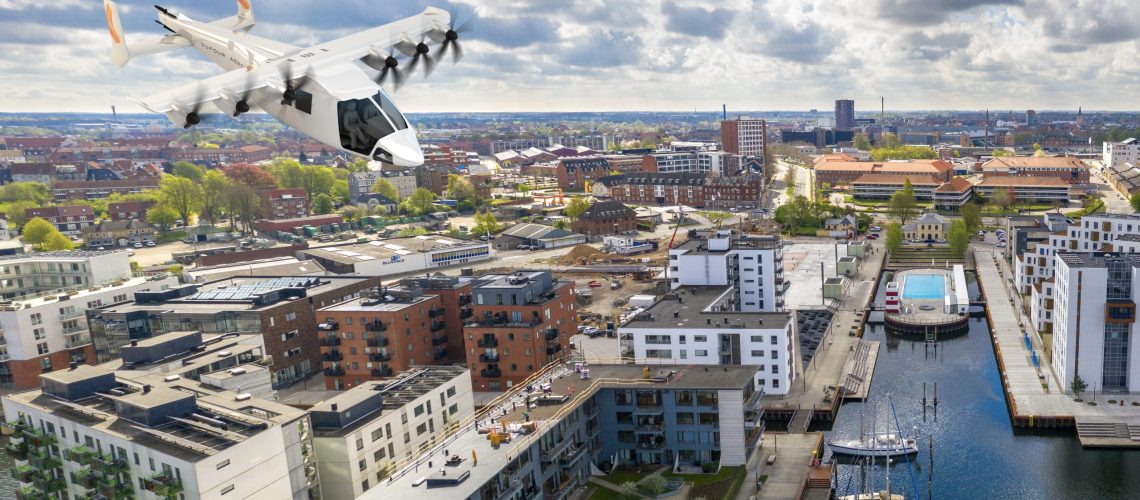A new partnership between HCA Airport in Odense and Copenhagen Helicopter will be the first in Denmark to build an infrastructure for electrically-powered flying taxis to ferry people between the country’s largest cities. Before the summer holidays, the first flying taxi is supposed be launched over Funen, and the end-goal is to establish a landing site on top of Odense Station.
A fleet of CO2-neutral flying taxis carrying passengers between Odense, Copenhagen and other Danish and European cities?
It may sound like pure science fiction, but cities like Los Angeles, Munich and Seoul are already paving the way for a whole new layer of green infrastructure called AAM – Advanced Air Mobility.
A new Danish partnership consisting of HCA Airport in Odense and the company Copenhagen Helicopter ApS is now taking the first steps towards getting flying taxis – also called eVTOL, electric vertical take-off and landing aircraft – into Danish airspace. The aim is to showcase the first flying taxi by summer 2023, and in the slightly longer term the goal is to establish one or more landing sites, so-called vertipads or vertiports, in Odense – initially on top of Odense Station.
A brand new infrastructure
“I foresee that in a few years’ time you can take the light rail to Odense Station and from there take a flying taxi to Copenhagen or other Danish cities. Now is the time to start building a brand new infrastructure based initially on manned flying taxis that fly on green power and contribute to the government’s goal of achieving 100% green domestic transport by 2030,” says HCA Airport Chairman Kim Kenlev.
“I see nothing stopping us from flying to cities like Gothenburg, Hamburg or Berlin in the future. Advanced Air Mobility is high on the agenda everywhere, and these cities are within reach of these flying taxis,” he adds.
Will attract foreign operators
Initially, the partnership wants to attract foreign AAM operators to HCA Airport, which already hosts an internationally recognised drone test centre, UAS Denmark Test Center. This could be in the form of testing and demonstration activities or, in the longer term, service and maintenance.
“Advanced Air Mobility is based on a new revolution in aviation that says goodbye to fossil fuels in favour of electrification and biofuels – which we already know from the transition from traditional cars to hybrid and electric cars and later self-driving cars. It offers a whole new opportunity to transport people on a daily basis via the skies, while reducing greenhouse gas emissions, reducing noise levels and much more,” says CEO of Copenhagen Helicopter, Martin Andersen.
Copenhagen Helicopter offers transport such as taxi flights in traditional helicopters, which the company says is a growth area. According to Andersen, Copenhagen Helicopter’s own calculations, which are based on international and national reports, indicate that the AAM area has huge potential and could transport 84,000 passengers a day and remove 120,000 tonnes of CO2 from Danish roads by 2035.
Disrupting domestic transport
The Municipality of Odense shares the goal for establishing more sustainable modes of transport and for setting high standards in order to be the first to develop new technologies:
“This could well be the beginning of what will be a whole new way of transporting ourselves and goods in the future. We can see that other countries and cities are already way ahead, and Denmark and Odense must of course also follow this trend. The flying taxis of the future can fly on green power produced by Danish offshore wind turbines, and they can help shift traffic away from the roads,” says the mayor of Odense Municipality, Peter Rahbæk Juel.
He believes the goal of putting Odense at the forefront of the development is a natural extension of the city’s long-standing strong position in robotics and drone technology, among other areas:
“Funen’s robotics adventure began with some talented engineers from the University of Southern Denmark and a city that dared to think big and take a risk. In the same way, I see this as the first steps towards a new business venture that will hopefully generate jobs, contribute to the green transition and create a whole new way of transporting people,” says Juel.
An area in huge development
In countries like Korea and Germany, as mentioned above, the framework for flying taxis to take to the skies – initially with a pilot on board – is relatively advanced.
In Seoul, for example, the goal is to have regular drone flights across the mega city as early as 2025, and in Germany an Airbus-led partnership involving Deutsche Bahn, Munich Airport and Telekom, among others, is working on making flying taxis between German cities a reality. A total of €86 million – equivalent to DKK 645 million – has been earmarked for this project over the next three years.
And in the US, in early 2022 Boeing invested more than DKK 3 billion in the Silicon Valley company Wisk Aero, which is developing a self-flying propeller aircraft.
Fotocredit: Sebastian Thomas Bay


